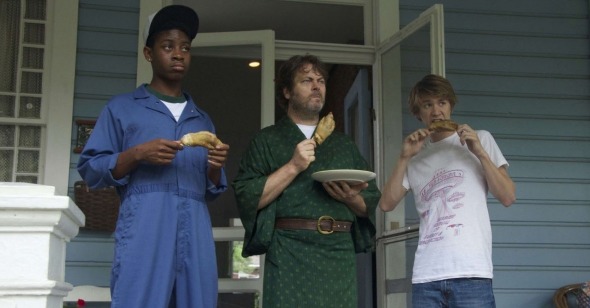11 Offenses of 2015
Though we’ve been expectorating this column annually for more than ten years, we still feel something of a preamble is in order. Our annual 11 Offenses list (crucially featuring one more title than our best line-up) is not to be taken as Reverse Shot’s official worst-of-the-year list. That’s never been its intent. We feel there’s no way to accurately come to such a conclusion, especially given how few of our writers likely took the time to watch such widely derided entertainments as The Cobbler, Fantastic Four, Entourage, or Mortdecai. We’re not even sure if any of those in our ranks forced themselves to suffer through the latest Gaspar Noé thing called Love. Most of us are not weekly or even regular critics, so we can pick and choose, and we can avoid obvious dross with some freedom. While we’re lucky in this regard, we do remain a bunch of easily antagonized 21st-century movie lovers, for whom time is too increasingly precious to waste on prestige Europudding, overhyped comedies direct from Dumbdance, ultraviolent ultra-“stylish” Brit-shit, and another specious Holocaust “art” film. Some of these 2015 films have already been rightly forgotten; others are currently watching the awards sluice in like the leftover animal parts used for Chicken McNuggets. We show no bias about the types of films we hate: they come from high or low, left or right, mud puddles or scum ponds. You may disagree with us and think that something on this list is actually quite wonderful and worthy. In the spirit of fairness, just know this: you’re wrong.
[Capsules by Julien Allen, Ashley Clark, Leo Goldsmith, Eric Hynes, Michael Koresky, Violet Lucca, Ben Mercer, Adam Nayman, Jeff Reichert, and Farihah Zaman.]
Me and Earl and the Dying Girl
In the preening indie dramedy Me and Earl and the Dying Girl, which Fox Searchlight bought for eight figures at Sundance and put out midsummer, a white, middle-class high-schooler named Greg Gaines (Thomas Mann) ostensibly learns some valuable life lessons with the help of his poor black friend Earl (RJ Cyler) and a leukemia-stricken classmate named Rachel (Olivia Cooke). The setup is enough of a groaner on its own, but the truly galling part of the movie—directed by Alfonso Gomez-Rejon and adapted by Jesse Andrews from his own best-selling YA novel—is its pointed lack of interest in anyone different from its whiny protagonist. Greg’s self-centered M.O. at school is to be so blandly likable that he makes no impression at all on his peers, but as Rachel embarks on a punishing chemo regimen, she’s lucky the cutup can find the time to just be himself around her. Greg and Earl spend most of their hours, though, making miniature parodies of film-buff starter classics (“A Sockwork Orange,” “Pooping Tom,” etc). While the former assumes the trash-auteur mantle, the latter does little besides utter the words “dem titties”—though the film does take just enough time to gawk at Earl’s crumbling residence on the wrong side of the tracks. That Me is otherwise so insistently self-aware—chapter-book title cards like “This is the part where I get into my first fight ever” divide the action—makes its narrow-mindedness all the more noxious. —BM

Youth
“Life goes on without that cinema bullshit,” barks Brenda Morel (Jane Fonda) late in Youth. For those of us who consider Paolo Sorrentino’s cinema to be comprised almost exclusively of bovine leavings, the line could be taken as an invitation to flee the theater and do literally anything else with our precious time. A glossy comedy-drama in the same intellectual-chic mode as The Great Beauty—but now featuring the sorts of Western movie stars attracted by the opportunity to act for a newly minted Oscar winner—Youth presents itself as a meditation on aging, but its real subject is genius, or at least Sorrentino’s notion of it. The casual musical mastery of retired composer Fred Ballinger (Michael Caine) is clearly meant as a stand-in for his director’s own imagined brilliance. The idea seems to be that while bodies decay and relationships erode, artistry endures, which is true enough, except that the accomplishments of Sorrentino’s assembled avatars —including Fred’s film director friend (Harvey Keitel) and a shape-shifting young movie star (Paul Dano)—feel totally ersatz. It’s shocking how unpersuasive this gadfly-ish auteur is when it comes to sketching characters in his peer group, and as in The Great Beauty he seems unsure of whether he’s critiquing callow first-class largesse or luxuriating in it (the film is set at a deluxe alpine spa). Instead of fertilely mining the gap between artifice and authenticity, Youth simply tumbles in and disappears—and without a trace, at that. —AN
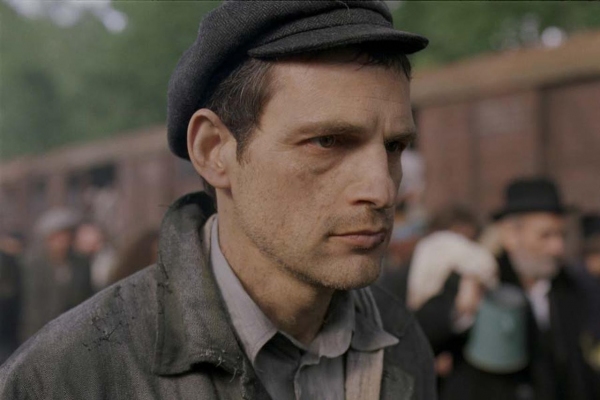
Son of Saul
This is how Son of Saul begins: the camera stays uncomfortably close to our antihero, concentration camp prisoner and sonderkommando Saul (Géza Röhrig)—huddling by his shoulder or scanning his blank face—as he hurriedly rounds up his fellow Jews, helping them undress before herding them into a small chamber, locking the door behind them. The camera is so unbearably intimate, so abstracting in its closeness, that we are not entirely sure at first what we are looking at. It all becomes horribly clear, however, when, as Röhrig’s blankly anguished face fills the frame, we hear the gasping breaths and grasping hands as they pound at the closed door. Cut to black. BOOM: title emblazoned on the screen. This opening should immediately clue the viewer in that director László Nemes, in his feature debut, is focused on creating something experiential out of historical tragedy, like an art-film rollercoaster. What makes his showman’s instincts galling is that they are so hubristically wedded to a strict moral philosophy. From Adorno’s famous dictum (“to write a poem after Auschwitz is barbaric”) to Jacques Rivette’s attack on the tracking shot in Gillo Pontecorvo’s Kapò to the eternal debates over Claude Lanzmann and Steven Spielberg’s differing cinematic takes, each alleged by others to be purposely “definitive,” Holocaust representation has long been subject to the highest scrutiny—resulting in arguments over what is right and wrong, what is possible and not. Nemes’s film, a work of appalling craftsmanship, has clearly followed the critical discourse closely, as it comes with its own built-in self-protection: by adhering to its protagonist’s subjectivity, it pretends to keep its horrors largely off-camera, always implying that its aesthetic approach is The Right One. We are invited to find it proper, even tasteful, because we hear rather than see murder, or because images of humans being shot in the head and dropped into pits are kept out of focus. It’s not a cinema of ideas, but one of rigidity, constructed entirely of an arbitrary set of moral principles; it was even given the thumbs up from the 90-year-old Lanzmann, who has long rejected the notion that the Holocaust is dramatically representable onscreen, but whom Nemes was savvy enough to consult during production. Lanzmann might as well have given his blessing to Life Is Beautiful: in its surety of itself, Son of Saul is as grotesque and exploitative as any of the Holocaust films that routinely meet with righteous condemnation. —MK

Kingsman: The Secret Service
If popular films reflect the politics of the era in which they are made, then I guess we get the multiplex entertainment we deserve. The climactic sequence of Kingsman: The Secret Service, a sub–Zack Snyder abortion of an action film, absolutely dripping with fascistic smugness, features Colin Firth committing genocide in a church. It’s a gorefest that aims for an Inglourious liberal catharsis (the parishioners are all right-wing, gay-bashing racists), but instead proves as powerful a calling card for the religious right as anything Mel Gibson would contemplate directing. With a smart-ass script aimed squarely at hormonal teenaged boys in the first throes of contemplating suicide because of how important they think they are, it mixes empty, sophomoric nihilism (all the world’s heads of state eventually explode), a bizarrely retrograde “new lad” obsession with grooming and tailoring (see also bore-fests Spectre and The Man from U.N.C.L.E.), product placement dressed up to look like a joke (Wayne’s World did it almost 25 years ago), and a central plot device stolen from Batman Forever. By the time we reach the rebarbative final pay-off involving our young hero “Eggsy” having anal sex with a minor European royal, reserves of goodwill may be running low. Colin Firth is incredible, which is to say not remotely credible (why attempt a different cut-glass RP English accent from the one you already own?), while Samuel L Jackson, capable of titanic character performances, essays a “crass American” jillionaire bad guy with a baseball cap and a lisp: one of the most pathetic and incoherent film villains since Dennis Hopper banked his check for Super Mario Bros. Guy Ritchie acolyte Matthew Vaughn’s humor is of the increasingly common, hateful-but-it’s-only-a-bit-of-fun-except-no-it-isn’t variety and his penchant for derivative ultraviolence (coated in a thin veneer of comic-book sensibility) is physically and intellectually brutalizing. To the many valuable reasons for preserving the use of 35mm film stock in distribution, we can now add one more: it allows us to call for every last copy of Kingsman: The Secret Service to be burned. —JA

Sicario
From the country that brought you ICE raids and a leading presidential candidate who called Mexican immigrants criminals and rapists comes . . . Sicario! Directed by Quebecois import and future Blade Runner–defiler Denis Villeneuve, the film stars Benicio del Toro (reprising his role as Intense, Morally Ambivalent Latino) as the titular Medellín assassin who teams with Josh Brolin’s flip-flop-wearing CIAsshole and Emily Blunt’s neophyte FBI agent to take down the Mexican cartels. Because the border is a place of murkiness and illogic, one could perhaps forgive the script, penned by Sons of Anarchy bit player Taylor Sheridan, for making no sense, and indeed it does a creditable job fashioning outdated Internet articles about Juárez's drug violence into a taut, nonspecific thriller. One might even say it’s appropriate that Blunt’s hotshot agent takes a moment early in the film to do some very belated background research via Google Image Search to figure out just how bad Mexico is. But these are also indicators of the filmmakers’ assumptions that its characters and audiences know and care as little about the drug wars as they do. Rather than contend with the chilling details and deeply disturbing complexities of a film like, say, Gianfranco Rosi & Charles Bowden’s 2011 documentary El Sicario, Room 164, why not transpose the blinkered U.S. news media’s perspective on Mexico into the visual tropes of 21st-century cinematic spectacle instead? Add a veneer of professionalism courtesy of DP Roger Deakins and a telegraphed contempo vibe via Jóhann Jóhannsson’s post-Zimmer electronic score, and the stage is set for a full integration of Fox News immigration coverage and Hollywood fairy tale, wherein the fog of the “drug war” neatly dovetails with one character’s personal, 'feminine' struggles with Right and Wrong, and where desperate times call for desperate measures—tough, masculine, paramilitary measures like enhanced interrogation, assassinations, and a little flouting of international law. Apparently, even after Zero Dark Thirty barely obscured its White House–authorized message of “all’s fair in the War on Terror,” Hollywood still manages to convince audiences that political stuff is just too complicated to understand, much less do anything about. Funny thing, though: it turns out that this faux moral ambiguity, viewed from the reassuring distance of commercial cinema, is so damned entertaining. What else do you think Sean Penn and escaped Sinaloa cartel kingpin Joaquin “El Chapo” Guzman talked about during their power lunch? —LG
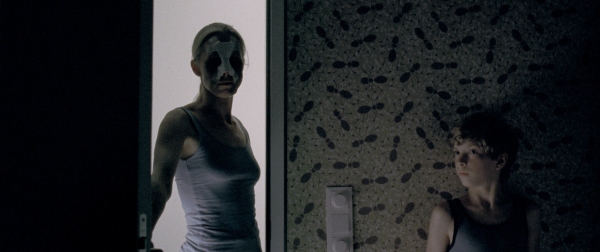
Goodnight Mommy
Have you been feeling a little too clean lately? Then why not take a dip in the pseudointellectual cesspool that is Goodnight Mommy? This utterly unimaginative horror yarn—which actually pulls out the old “this main character’s been dead the whole time!” third-act twist—gussies up its (mostly facial) torture porn with brief allusions to Austria’s Nazi past. Creepy Aryan twins Elias and Lukas (a.k.a. the dead one—spoiler!) are spending time at their TV presenter mother's summer home in Lower Austria while she recovers from cosmetic surgery. The film offers a de rigueur art-house formalism, featuring some ultramodern interior design, but the film’s real offense is its take on gender, starting with conspicuously placed props half-heartedly reflecting society’s beauty expectations for women, either cutting the head off of a female figure or reducing it to curves (a dress form; some porcelain dolls; blown-up, blurry photos of Mommy decorating the walls). The act of describing this theme almost gives credence to its symbolism—except that filmmakers Veronika Franz and Severin Fiala waste more screen time unsuccessfully trying to build up tension as to whether or not the film’s main monster, Mommy, is really the twins’ mother or not, and showing how lousy a parent she can be. Neglecting Elias for hours as she sleeps and then slapping him around when they're together, Mommy shows a need to put herself first—and her ultimate, graphic punishment comes off as a bad joke. The film’s lowest point comes in the form of a sub-Haneke punch line: two elderly, dopey Red Cross volunteers come to the door seeking donations while Mommy’s bound and gagged in the upstairs bedroom—but she only manages to ungag herself and scream for help after they’ve left. Meditations on modern motherhood deserve something more complicated than ironic punishments that could have been dreamt up by a vengeful brat having a time out. —VL
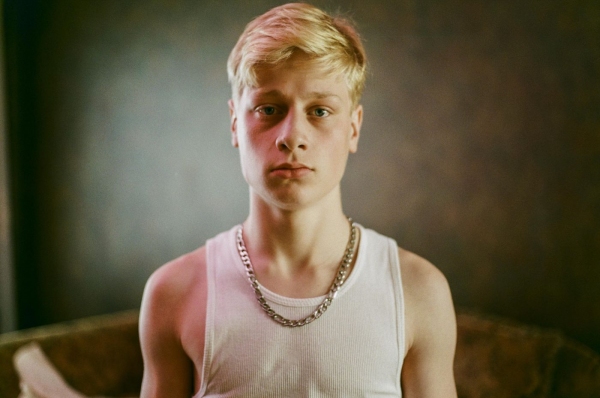
Mommy
I’ve already written elsewhere about my frustrations with the fawning critical response—at least up here in Canada—to Xavier Dolan, which crystallized in 2014 at Cannes with Mommy; what’s been revealing is seeing how comparatively disinterested my American peers have been with this latest over-hyped prize-winner now that it’s received its Stateside release. As melodrama, this story of a put-upon single mom (Anne Dorval) trying to come to terms with her unruly teenage son is exactly as florid as its maker intends; what’s more irritating is its speculative-fiction framing device, which imagines a “fictional Canada” in which parents are free (if not encouraged) to remand their kids to specialized institutions. Besides feeling like a feeble stab at social commentary from a filmmaker feeling the pressure of being a country’s new cinematic laureate, this twist enables an already over-moist movie to end on the most sentimental note possible. I just don’t buy the argument that boisterous rage-monster Steve (Oliver Pilion) is being illuminated through the prism of his mother’s unconditional love; Dolan always beautifies (and beatifies) his problem-child characters, probably out of transplanted self-regard. This strategy has frankly grown tiresome, even over a short period of time. I’d also argue that any movie that forces an audience to listen to all four-and-a-half minutes of Counting Crows’ “Colorblind” is offensive in and of itself; Roger Kumble’s Cruel Intentions—a frankly superior movie featuring pretty, sociopathic teenagers—had the decency to use it only in excerpt. —AN
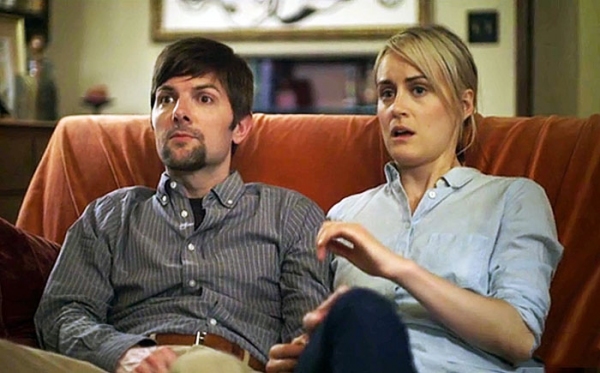
The Overnight
Are you the intended audience for The Overnight? Well, let’s see: are you white, middle-class, married, a parent of young children, a resident of Silver Lake in Los Angeles, nominally liberal yet more than a bit skittish about social and sexual deviance, and cosmopolitan but more than a bit dismissive of bohemians? This is a film that may speak to you, all 4,000 of you. But I wouldn’t be too flattered. Sure, it’s not so bad that you’ve been portrayed by Adam Scott and Taylor Schilling. And who among you wouldn’t be intrigued and flattered if Jason Schwartzman and a French actress wanted to make friends with you. But in all your 32 to 42 years on this earth, have you never met a bisexual person? Have you never met people who have an open marriage? Have you never been in the same room as a naked male? Do you remain easily titillated or grossed out by the mention or sight of pubic hair, micro penises, or assholes? Truly, have you never seen an asshole, my milquetoast Silver Lake friend? This is a film that assumes you’ve only ever Googled these things, if that, and that you’re due to have your limited life experience and narrow worldview challenged over the course of a single fictional night. But don’t worry, you won’t actually have to see a human penis—there are comically non-anatomical prosthetics for that. And don’t worry, you’ll be saved from your drunken and stoned willingness to open your mind and body to new experiences by the blessed intervening peals of children and a script lacking in bravery, conviction, or a single joke that doesn’t assume the worst about you, or affirm the ickiness about that which you fear. And take heart, because in the end, all will be nearly the same as it was before. Maybe your marital rutting will have a smidge more kink to it. Maybe you’ll own the knowledge that you’ve met a genuine swinger. And if you follow the lead of your conduits in The Overnight, you might be even smugger than you were before. —EH

The Tribe
At this point in the history of image-making, with thousands of years under our belts, from cave paintings to cutting edge VR, one shouldn’t have to note that there’s a crucial difference between artists who feature venal acts and disturbing situations for the purposes of commenting upon them, and those who do it just because they can. Nevertheless, it seems with each new season there’s a hot new “talent” on the scene like the Ukraine’s Miroslav Slaboshpitsky who didn’t get the memo, gleefully rubbing our noses in one degradation after another. His debut feature, The Tribe, is horribly unpleasant, from the sterile, seemingly pleasureless sex that leaves its young female stars especially vulnerable, to the increasingly extreme violence, to the more conceptually discomfiting ways in which economic imperatives encourage all the people in it to each treat each other as commodities just ready for exchange. Don’t let that last observation make you think for a second that this is a film of ideas, however, as even the most dimwitted of college freshmen has likely had that same “a ha!” moment after a couple of late-night tokes. No, The Tribe is mean and gross and venal for the sake of it, not for illuminating us about the state of the Ukraine or for offering new insights into human behavior. Even its supposed “innovation”—being shot entirely with deaf actors and left un-subtitled, thus forcing viewers to work to discern the narrative through pictures, performance and gesture—only fitfully makes one ponder the mysterious powers of cinema. The only thing more depressing than these 126 pummeling minutes, a beat-down thoroughly abetted by admittedly impressive, intricately choreographed, and wholly unforgiving Steadicam moves (where are we to look in this vile morass that is life!?), may be the plaudits thrown its way and its regular appearance on year-end best lists. If we were to speak of The Tribe using its own language of choice, and on its puerile intellectual level, might I suggest simply that a middle finger raised in its direction just about says it all?—JR

Legend
Peter Medak’s creepy, chilly 1990 thrillerThe Krays—which starred Spandau Ballet musicians Gary and Martin Kemp as real-life ’60s East End gangster twins Ronnie and Reggie Kray—offered a psychologically nuanced portrait of two violent, seedy egotists entwined in an unhealthy relationship with their overbearing mother (the late, great Billie Whitelaw). No comparable traces of restraint or intelligence can be seen in Brian Helgeland’s slick yet clodhopping Legend, a star vehicle for Tom Hardy who portrays both men; for the record, he’s fine as the more level-headed Reggie, and thunderously hammy as bespectacled, maniacal homosexual Ronnie. I’d hoped from the title that the American Helgeland would attempt to unpack the dubious reverence (in some media quarters) of these men, and bring a fresh, outsider’s spin to the East London setting—consider David Cronenberg’s idiosyncratic imaginings of the area in Spider and Eastern Promises. The writer-director, however, is distressingly uncritical; he’s clearly smitten by the Krays, and strives to titillate the viewer by having the boys dispense repetitive, caperish slabs of gratuitous violence and gratingly arch wisecracks. Helgeland also resoundingly fails to foster a sense of place, his East End a weirdly anonymous parade of rubbed-clean rowhouses and suspiciously sparkling pubs. The film’s sole intriguing formal conceit is a framing narration by Reggie’s young belle, Frances, a wan waif tremblingly played by Emily Browning. Sadly, Frances’s voiceover is a thuddingly banal string of clichés, and her eventual tragic fate, clearly intended to be the film’s emotional knockout, occurs as a rushed afterthought. The whole rancid pie is garnished with reams of knuckle-suckingly witless dialogue (“The world is quite like London. It’s not good. It’s not bad. It just is”) and musical cues that aren't so much “on the nose” as “forced up your nostrils” (the Dixie Cups’ “Chapel of Love” scores . . . a wedding!). The final insult? To my home nation’s eternal shame, Legend scored the biggest-ever opening in history for an 18-rated film in UK cinemas. —AC
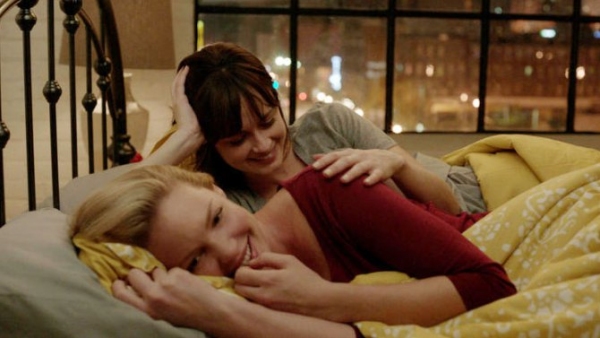
Jenny’s Wedding
This was the year that same-sex marriage was legalized across the U.S., and some of 2015’s best films—Reverse Shot list toppers Carol, Clouds of Sils Maria, and Eastern Boys, among others—reflected this queer new world. Then there was Jenny’s Wedding, a romantic comedy that happens to be neither romantic nor comedic, following the uptight thirtysomething title character (Katherine Heigl) as she comes out to her uptight family when she decides she wants to marry her longtime partner (Alexis Bledel). The film rides the coattails of the current political moment, clearly trying to position itself as the mainstream face of American lesbianism, but phones it in too hard for anyone to relate to its characters, gay or straight. While the legalization of gay marriage no more eradicates homophobia than the election of President Obama has wiped out racism, the complete bewilderment of Jenny’s family is outdated to the point of undermining its allegedly tolerant message. The members of this upper middle-class clan, who lives in suburbs right outside of a cosmopolitan city, react as if they have literally never heard of a gay person before, and each is thrown into a personal crisis by Jenny’s news. Hey kids, gay marriage really does threaten the very fabric of the family unit! What’s so frustrating about this charmless dud is its wasted potential. It understands some truths—that sexual preference does not entirely define a gay person and does not automatically make them subversive, and that someone can be gay and yet completely old-fashioned in her desires and values—but is so misguidedly fixated on delivering this message that every character is reduced to a soulless broken record. Tom Wilkinson’s father shares a series of grumpy platitudes about marriage; Mamie Gummer’s bitter sister whines about the overly symbolic grass that’s dying behind her white picket fence; Bledel’s anonymous fiancée looks around with wide-eyed concern while exhibiting no real personality. There should be mainstream American stories about homosexuality; they should probably just be told using actual humans. —FZ
